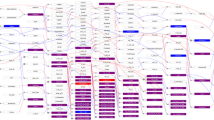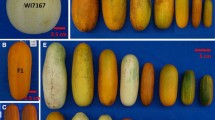Abstract
Key message
QTL analysis in multi-development stages with different QTL models identified 12 consensus QTLs underlying fruit elongation and radial growth presenting a dynamic view of genetic control of cucumber fruit development.
Abstract
Fruit size is an important quality trait in cucumber (Cucumis sativus L.) of different market classes. However, the genetic and molecular basis of fruit size variations in cucumber is not well understood. In this study, we conducted QTL mapping of fruit size in cucumber using F2, F2-derived F3 families and recombinant inbred lines (RILs) from a cross between two inbred lines Gy14 (North American picking cucumber) and 9930 (North China fresh market cucumber). Phenotypic data of fruit length and diameter were collected at three development stages (anthesis, immature and mature fruits) in six environments over 4 years. QTL analysis was performed with three QTL models including composite interval mapping (CIM), Bayesian interval mapping (BIM), and multiple QTL mapping (MQM). Twenty-nine consistent and distinct QTLs were detected for nine traits from multiple mapping populations and QTL models. Synthesis of information from available fruit size QTLs allowed establishment of 12 consensus QTLs underlying fruit elongation and radial growth, which presented a dynamic view of genetic control of cucumber fruit development. Results from this study highlighted the benefits of QTL analysis with multiple QTL models and different mapping populations in improving the power of QTL detection. Discussion was presented in the context of domestication and diversifying selection of fruit length and diameter, marker-assisted selection of fruit size, as well as identification of candidate genes for fruit size QTLs in cucumber.





Similar content being viewed by others
References
Ando K, Grumet R (2010) Transcriptional profiling of rapidly growing cucumber fruit by 454-pyrosequencing analysis. J Amer Soc Hort Sci 135:291–302
Ando K, Carr KM, Grumet R (2012) Transcriptome analyses of early cucumber fruit growth identifies distinct gene modules associated with phases of development. BMC Genom 13:518
Arends D, Prins P, Jansen RC, Broman KW (2010) R/qtl: high-throughput multiple QTL mapping. Bioinformatics 26:2990–2992
Azzi L, Deluche C, Gévaudant F, Frangne NF, Delmas F, Hernould M, Chevalier C (2015) Fruit growth-related genes in tomato. J Expt Bot 66:1075–1086
Bates DM (2010) lme4: mixed-effects modeling with R. http://lme4.r-forge.r-project.org/book
Bo KL, Ma Z, Chen JF, Weng Y (2015) Molecular mapping reveals structural rearrangements and quantitative trait loci underlying traits with local adaptation in semi-wild Xishuangbanna cucumber (Cucumis sativus L. var. xishuangbannanesis Qi et Yuan). Theor Appl Genet 128:25–39
Boonkorkaew P, Hikosaka S, Sugiyama N (2008) Effect of pollination on cell division, cell enlargement, and endogenous hormones in fruit development in a gynoecious cucumber. Scientia Hort 116:1–7
Broman KW, Wu H, Sen Ś, Churchill GA (2003) R/qtl: QTL mapping in experimental crosses. Bioinformatics 19:889–890
Candolle AD (1959) Origin of cultivated plants. Hafner Pub. Co., New York
Cavagnaro PF, Senalik DA, Yang L, Simon PW, Harkins TT, Kodira CD, Huang S, Weng Y (2010) Genome-wide characterization of simple sequence repeats in cucumber (Cucumis sativus L.). BMC Genom 11:569
Cheng ZC, Gu XF, Zhang SP, Mail H, Zhang RW, Liu MM, Yang SJ (2010) QTL Mapping of fruit length in cucumber. China Veg Issue 12:20–25 (in Chinese)
Chusreeaeom K, Ariizumi T, Asamizu E, Okabe Y, Shirasawa K, Ezura H (2014) A novel tomato mutant, Solanum lycopersicum elongated fruit1 (Slelf1), exhibits an elongated fruit shape caused by increased cell layers in the proximal region of the ovary. Mol Genet Genomics 289:399–409
Dijkhuizen A, Staub JE (2002) QTL conditioning yield and fruit quality traits in cucumber (Cucumis sativus L.): effects of environment and genetic background. J New Seeds 4:1–30
Fu F, Mao W, Shi K, Zhou Y, Yu J (2010) Spatio-temporal changes in cell division, endoreduplication and expression of cell cycle-related genes in pollinated and plant growth substances-treated ovaries of cucumber. Plant Biol 12:98–107
Gillaspy G, Ben-David H, Gruissem W (1993) Fruits: a developmental perspective. Plant Cell 5:1439–1451
He XM, Li Y, Pandey S, Yandell B, Pathak M, Weng Y (2013) QTL mapping of powdery mildew resistance in WI 2757 cucumber. Theor Appl Genet 126:2149–2161
Huang S, Li R, Zhang Z et al (2009) The genome of the cucumber, Cucumis sativus L. Nat Genet 41:1275–1281
Jiang L, Yan SS, Yang WC, Li YQ, Xia MX, Chen ZJ, Wang Q, Yan LY, Song XF, Liu RY, Zhang XL (2015) Transcriptomic analysis reveals the roles of microtubule-related genes and transcription factors in fruit length regulation in cucumber (Cucumis sativus L.). Sci Rep 5:8031. doi:10.1038/srep08031
Keng H (1974) Economic plants of ancient North-China as mentioned in Shih-Ching (Book of Poetry). Econ Bot 28:391–410
Kennard WC, Havey MJ (1995) Quantitative trait analysis of fruit quality in cucumber: QTL detection, confirmation, and comparison with mating design variation. Theor Appl Genet 91:53–61
Kuznetsova A, Brockhoff PB, Christensen RHB (2013) lmerTest: Tests for random and fixed effects for linear mixed effect models (lmer objects of lme4 package). R package V2.0-3
Marwede V, Schierholt A, Mollers C, Becker HC (2004) Genotype × environment interactions and heritability of tocopherol contents in canola. Crop Sci 44:728–731
Miao H, Gu XF, Zhang SP, Zhang ZH, Huang SW, Wang Y, Cheng ZC, Zhang RW, Mu S, Li M, Zhang ZX, Fang ZY (2011) Mapping QTLs for fruit-associated traits in Cucumis sativus L. Sci Agri Sinica 44:5031–5040
Monforte AJ, Diaz AI, Cano-Delgado A, van de Knaap E (2014) The genetic basis of fruit morphology in horticultural crops: lessons from tomato and melon. J Exp Bot 65:4625–4637
Owens KW, Bliss FA, Peterson CE (1985) Genetic analysis of fruit length and weight in two cucumber populations using the inbred backcross lines. J Am Soc Hort Sci 110:431–436
Paris HS, Daunay MC, Janick J (2012) Occidental diffusion of cucumber (Cucumis sativus) 500–1300 CE, two routes to Europe. Ann Bot 109:117–126
Qi JJ, Liu X, Shen D, Miao H, Xie BY, Li XX, Zeng P, Wang SH, Shang Y, Gu XF et al (2013) A genomic variation map provides insights into the genetic basis of cucumber domestication and diversity. Nat Genet 45:1510–1515
Rodriguez GR, Munos S, Anderson C, Sim SC, Michel A, Causse M, Gardener BBM, Francis D, van der Knaap E (2011) Distribution of SUN, OVATE, LC, and FAS in the tomato germplasm and the relationship to fruit shape diversity. Plant Physiol 156:275–285
Rubinstein M, Katzenellenbogen M, Eshed R, Rozen A, Katzir N, Colle M, Yang L, Grumet R, Weng Y, Sherman A, Ophir R (2015) Ultra high-density linkage map for cultivated cucumber using a single nucleotide polymorphism genotyping array. PLoS One 10:e0124101
Sebastian P, Schaefer H, Telford IRH, Renner SS (2010) Cucumber (Cucumis sativus) and melon (C. melo) have numerous wild relatives in Asia and Australia, and the sister species of melon is from Australia. Proc Natl Acad Sci 107:14269–14273
Smith OS, Lower RL, Moll RH (1978) Estimates of heritabilities and variance components in pickling cucumber. J Am Soc Hort Sci 103:222–225
Strefeler MS, Wehner TC (1986) Estimates of heritabilities and genetic variances of three yield- and five quality traits in three fresh-market cucumber populations. J Am Soc Hort Sci 111:599–605
Van der Knaap E, Chakrabarti M, Chu YH, Clevenger JP, Illa-Berenguer E, Huang ZJ, Keyhaninejad N, Mu Q, Sun L, Wang YP, Wu S (2014) What lies beyond the eye: the molecular mechanisms regulating tomato fruit weight and shape. Front Plant Sci 5(article 227):1–13
Wang M, Liu SL, Zhang SP, Miao H, Wang Y, Tian GL, Lu HW, Gu XF (2014) Quantitative trait loci associated with fruit length and stalk length in cucumber using RIL population. Act Bot Boreal Occident Sin 34:1764–1770 (in Chinese with English abstract)
Wei QZ, Wang YZ, Qin XD, Zhang YX, Zhang ZT, Wang J, Li J, Lou QF, Chen JF (2014) An SNP-based saturated genetic map and QTL analysis of fruit-related traits in cucumber using specific-length amplified fragment (SLAF) sequencing. BMC Genom 15:1158
Whitaker TW, Davis GN (1962) Cucurbits. InterScience Publishers, London
Yandell BS, Mehta T, Banerjee S, Shriner D, Venkataraman R, Moon JY, Neely WW, Wu H, Smith R, Yi N (2007) R/qtlbim: QTL with Bayesian interval mapping in experimental crosses. Bioinformatics 23:641–643
Yang LM, Koo DH, Li Y, Zhang X, Luan F, Havey MJ, Jiang J, Weng Y (2012) Chromosome rearrangements during domestication of cucumber as revealed from high-density genetic mapping and draft genome assembly. Plant J 71:895–906
Yang XY, Wang Y, Jiang WJ, Liu XL, Zhang XM, Yu HJ, Huang SW, Liu GQ (2013a) Characterization and expression profiling of cucumber kinesin genes during early fruit development: revealing the roles of kinesins in exponential cell production and enlargement in cucumber fruit. J Exp Bot 64:4541–4557
Yang LM, Li DW, Li YH, Gu XF, Huang SW, Garcia-Mas J, Weng Y (2013b) A 1,681-locus consensus genetic map of cultivated cucumber including 67 NB-LRR resistance gene homolog and ten gene loci. BMC Plant Biol 13:53
Yuan XJ, Li XZ, Pan JS, Wang G, Jiang S, Li XH, Deng SL, He HL, Si MX, Lai L, Wu AZ, Zhu LH, Cai R (2007) Genetic linkage map construction and location of QTLs for fruit-related traits in cucumber. Plant Breed 127:180–188
Yuan X, Pan J, Cai R, Guan Y, Liu L, Zhang W, Li Z, He H, Zhang C, Si L, Zhu L (2008) Genetic mapping and QTL analysis of fruit and flower related traits in cucumber (Cucumis sativus L.) using recombinant inbred lines. Euphytica 164:473–491
Zeng ZB, Kao CH, Basten CJ (1999) Estimating the genetic architecture of quantitative traits. Genet Res 74:279–289
Zhou XY, Qin ZW, Wang XG (2005) Study of the market characters of cucumber (Cucumis sativus L.) germplasm. J Northeast Agri Univ 36:707–713 (In Chinese with English abstract)
Acknowledgments
The authors thank Linda Crubaugh and Kristin Haider for technical assistance. This research was supported by US–Israel Binational Agricultural Research and Development (BARD) fund (Grant number IS-4341-10). Relevant work in Y. Weng’s lab was also partially supported by a US Department of Agriculture Specialty Crop Research Initiative grant (project number 2011-51181-30661).
Conflict of interest
The authors declare that they have no conflict of interest.
Author information
Authors and Affiliations
Corresponding authors
Additional information
Communicated by S. Huang.
Electronic supplementary material
Below is the link to the electronic supplementary material.
122_2015_2544_MOESM1_ESM.pdf
Supplementary material 1. Fig. S1 Frequency distribution of plants or families of fruit size-related traits in F2, F3 (A, B) and RIL populations (C to K). (PDF 332 kb)
Rights and permissions
About this article
Cite this article
Weng, Y., Colle, M., Wang, Y. et al. QTL mapping in multiple populations and development stages reveals dynamic quantitative trait loci for fruit size in cucumbers of different market classes. Theor Appl Genet 128, 1747–1763 (2015). https://doi.org/10.1007/s00122-015-2544-7
Received:
Accepted:
Published:
Issue Date:
DOI: https://doi.org/10.1007/s00122-015-2544-7




